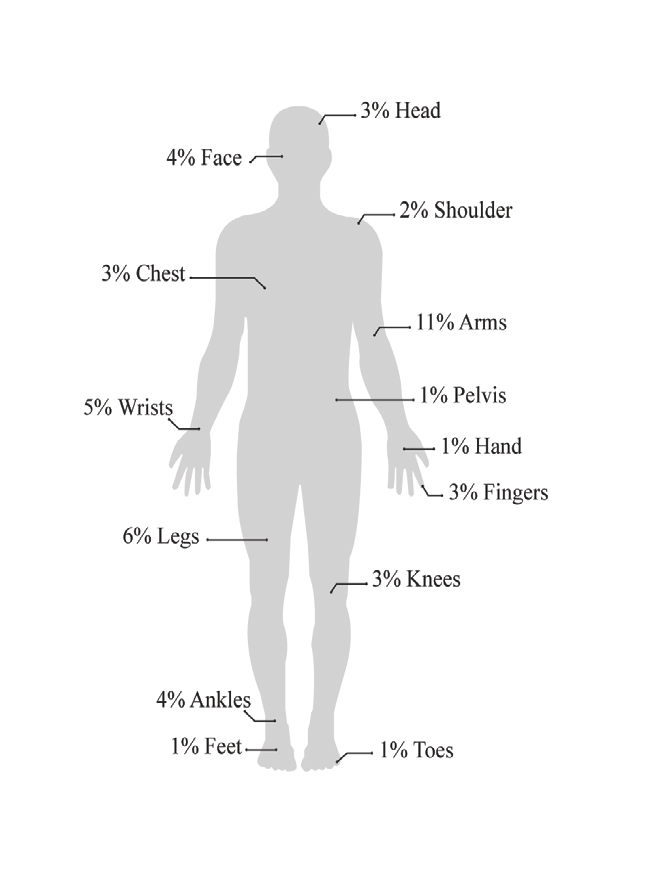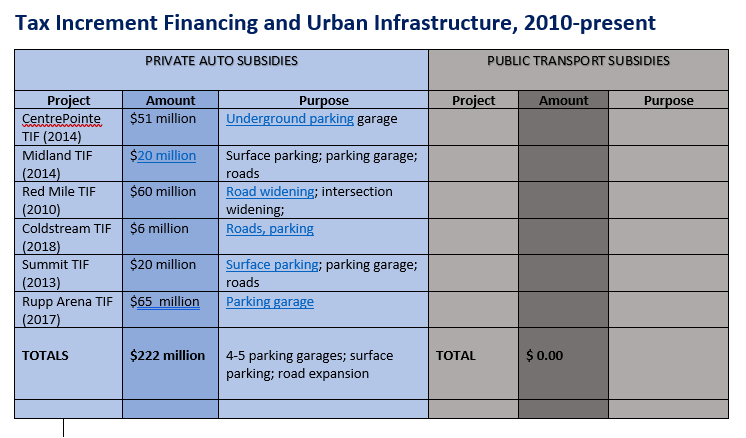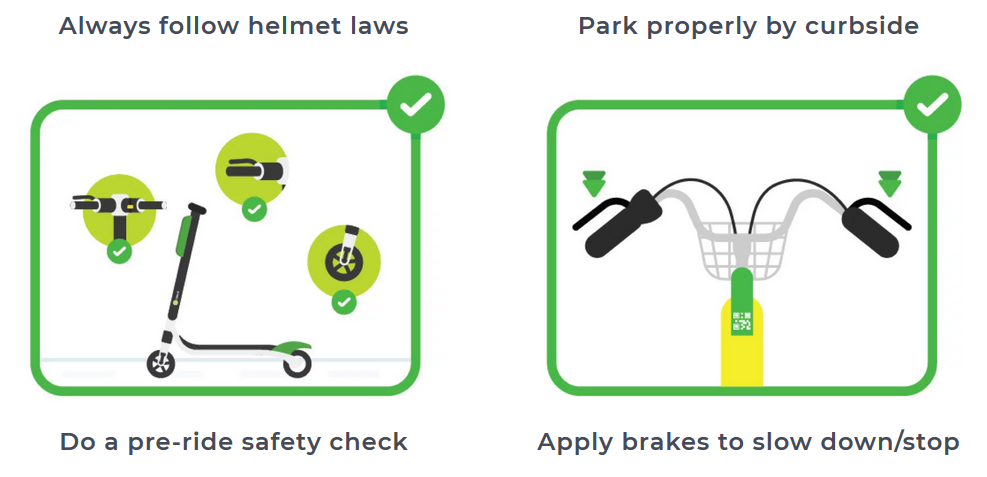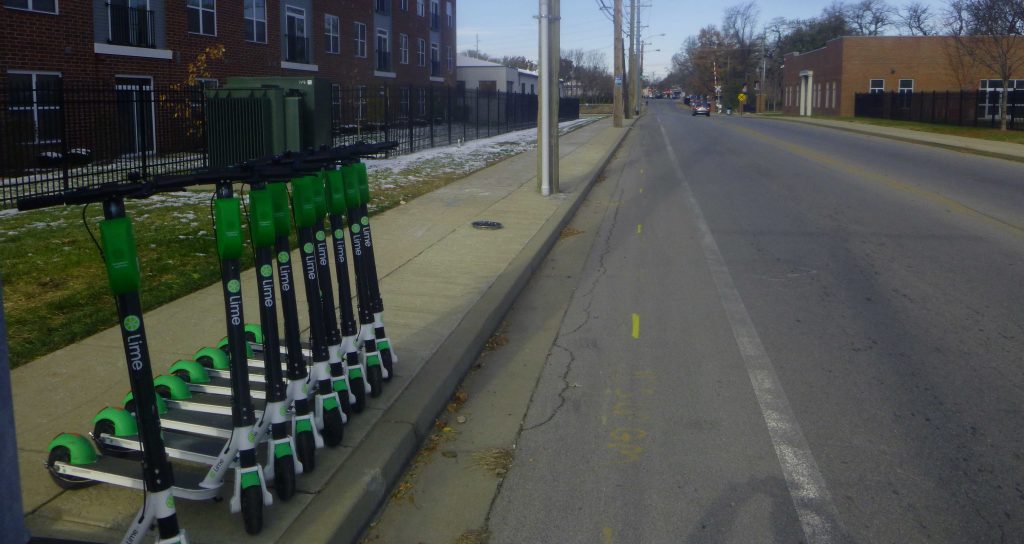Scooters and city infrastructure
Late last month, following several other progressive cities, Lexington legalized consumption of electric scooters within its urban services boundary. City ordinance 42-2019 authorizes up to five companies to operate dockless scooters and bikes on Lexington’s city streets, shared use trails, and bike lanes—but not on sidewalks.
The companies granted a license are required to locate, charge, and place scooters in designated areas each morning, in addition to general maintenance and oversight of the fleet. Currently, two scooter companies, Lime and Spin, are licensed to operate a total of 800 scooters, though the ordinance allows (with incentive goals) a total of 5,000 scooters in the city.
Thus far, the results have been mixed. Anecdotally, users seem to like them, as do local urbanists. But not everyone is thrilled: pedestrians are not big fans, and neither are many drivers of the city’s busiest streets.
And there is the steep accident rate. In under a month, one death on Richmond Road, when a scooter-ist lost control, pitched into traffic, and was hit by multiple cars. Two serious incidents near the scooter-dense campus of the University of Kentucky. And there is a likelihood that other scooter injuries—typically, broken wrists, ankles, arms and face, according to an Austin, Texas-based study of admittance records for nine of its area hospitals— are as yet undocumented in this city.

from “Dockless Electric Scooter-related injuries study.” Austin Public Health, Epidemiology and Public Health Preparedness Division, November 2018.
But even by themselves, the three reported injuries present the sort of accident rate, roughly 2.4 injuries per 20,000 trips, that would spark investigations had they involved LexTran buses (think Colt Trolley) or any other form of transit, really, throughout the country, where accident rates hover between .1 and .2 injuries per 20,000 trips.
It is tempting to attribute the cause of these accidents to the introduction of electric scooters. Don’t be made a fool: scooter infrastructure is non-auto infrastructure, and though few in this city have cared to state it directly, over the past decade we have produced terrible non-auto infrastructure. The ordinance allowing global tech companies to place scooter-ists on city streets has only magnified this problem, one borne of poor planning and development.
More broadly, then, the question of how the city will deal with scooters—their use and pathways and business practices—is really a question of how we will organize our urban future. Will we be proactive in making room for people to choose transportation options beyond cars and trucks? Will we continue to stumble on, the same old leadership blindly committing the same old carbon-burning mistakes as our warming world thrusts change upon us?
In the coming years, we can expect these infrastructure debates to arise many more times in a variety of different contexts. Whether you are a scooter-ist, a biker, or a pedestrian; a bus-rider, skater, or jogger; unicyclist or tricyclist; a hiker, skipper, or wanderer—hell, whether you are anything other than an automobiler—you should be very concerned.
Just consider the two main drivers of the city’s scooter debate:
Spin: Revision as solution
On the one hand, we have our city representatives, an elected body with a deep, abiding, and expensive history of (1) catering to auto-interests, (2) shilling for wealthy investors, and (3) demonstrating not a single whit of interest in non-auto, non-tourist transport in this city.
As arbiters of the public will, they have continued to spin cheap paint-on-a-road solutions (bike lanes, sharrows, deep green crosswalks) as acceptable and progressive non-auto infrastructure. Meanwhile, as holders of the public purse, these same elected leaders have promoted Lexington car culture by subsidizing the construction of parking garages, surface parking lots and widened-roads, mostly for projects that benefit their wealthy (car-driving) political benefactors.

Thus far, the Herald Leader reports, city leaders are dealing with these scooter externalities by spinning out more paint-on-a-road solutions. In this case, the painted solution to the poor roll-out of city scooters involves a revision to the city’s dockless mobility ordinance, which would allow scooters to access pedestrian sidewalks when riding on certain high-traffic roads (like Richmond). The problem, say our car-driving leadership, is that the city was not built for these newfangled scooters, which have only been in use in American cities since 2017. Council’s solution is the revision: scooters on local sidewalks.
Lime: Education as solution
On the other hand, we have the companies whose business model–dockless, rentable electric scooters–created the need for the city’s initial ordinance. For their part, representatives from Lime and Spin have expressed condolences to the family of the scooter-ist who died on Richmond Road. Otherwise, though, the companies have been quiet regarding Council’s scooter plans.
But money is speech, and Lime and Spin are well-endowed California start-ups. Responding to accidents in other cities, Lime reps have stated, “Safety is incredibly important to Lime, and we’re constantly educating our riders and developing new tools to promote safety and prevent accidents on our platform.” And indeed, the Lime app, much like its Spin counterpart, offers a meaty 2:21 second safety video of educational insights: proper hand-signaling, the value of mindfulness, obedience to all traffic laws, and helmets.

While we don’t know, publicly, their specific ideas for making scooters work here, we can make some informed guesses. The problem, Lime and Spin might say, are uneducated users not watching the fine-print. Their solution is consumer education: better videos to post on their apps, perhaps a few ‘hey watchyaself’ beeps installed for extra minding.
Fear the Lime and Spin partnership
Suffice it to say, more educated scooter-ists occasionally riding on sidewalks is not likely to solve our dockless mobility problems. And, more broadly speaking, local leadership partnering with global tech companies is not likely to solve Lexington’s non-car infrastructure dilemmas. Good solutions, as the saying goes, arise through a correct understanding of the problem. Misidentify or remain ignorant of the problem, and you’re likely to get less than satisfactory solutions.

Like good diversified corporations often do when they enter Country Bumpkin-territory, Lime and Spin will surely ever-so-slightly nudge our dimwitted local leadership in the good direction. Beyond its commitment to holding scooter-ists accountable for transit safety, Spin claims (unfunded) support for promoting better transportation infrastructure like bike lanes separated from roadways. “The most important action we can take to keep people safe,” Spin writes in a December 2018 blog post detailing its commitment to safety, “is to build smart infrastructure…. That’s why Spin is working to support community leaders doing the critical work of identifying the protected lane networks that are needed, and advocating for them to be built.”
Good for Spin. But one wonders at the implications of venture-capital funded California tech corporations playing the role of transit-advocate-in-the-room on matters of city transportation. For starters, what about local matters? A regional rep from Lime, in pre-scooter coverage, referred to Lexington as having “a very good infrastructure as far as bike lanes and the bike boxes.” One wonders, in what locations (and for what reasons) was this person biking in Lexington? What local transit knowledge are these corporations really projecting, anyway?
And yet, Lime and its tech-heavy, educate-the-scooter-ists brand of solutions will likely drive city infrastructure discussions. Lime, like Spin, will continue to partner with our city’s public sector nitwits, the law-writing and purse-holding ones who fed them all the branded crap in the first place about Lexington being bike friendly.
Parts 2, 3, and 4 of North of Center’s analysis of electric scooters and urban infrastructure will look at the growth of privatized on-demand transit; Lexington’s previous decade of investments in transportation infrastructure; and what an actual “smart” transportation infrastructure might look here.





Leave a Reply